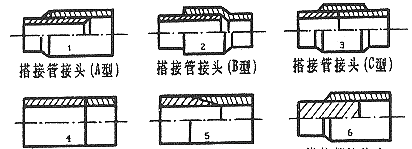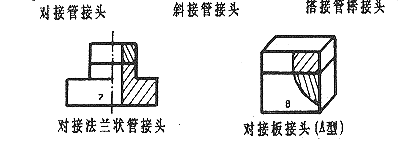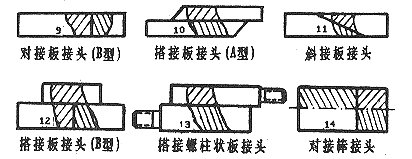Explosive Welding and Metal Composites (3)
It should be noted that all of the above structural metals also include their alloys. "Steel" also includes different types of ordinary steel, alloy steel and low alloy steel. There are dozens to hundreds of types of stainless steel, and bimetallic and polymetallic It can reverse the position of each layer, and it is not just five layers. In this case, the variety and number of the above metal combinations are far more than these. At present, the total number may be hundreds and thousands. In fact, it can be said that any combination of metal combinations can be produced by explosive welding as long as it is required in testing, production and science and technology.
The above metal explosive composite materials should be classified according to their nature and use:
1. Composite materials that make full use of metal chemistry. For example, titanium, zirconium, hafnium, tantalum, tungsten, molybdenum, copper, aluminum, precious metals, stainless steel, etc., which have good corrosion resistance in the corresponding chemical medium, and their composite sheets composed of ordinary steel have been widely used in Chemical and pressure vessels.
2. Composite materials that give full play to the physical properties of metals. For example, thermal bimetals (thermal-mechanical properties), bimetals for electrical, electronic and electrochemical (electrical properties), tuning fork bimetals (acoustic properties), worm wheel bimetals (cavitation resistance), guns (guns) Bimetal (ablative resistance), precious metal composite joint materials (corrosion resistance), composite superconducting materials (superconducting properties), composite magnetic materials (magnetic properties), and atomic energy composites (nuclear properties).
3. Composite materials that fully enhance and improve the mechanical properties of metals. For example, composite fiber reinforced materials (significantly improved tensile strength), composite armor materials (different hardness of each layer can significantly improve the ability of the material to resist armor), composite tool materials (high hardness of the blade part), anti-friction composite ( The inner layer material is resistant to friction and wear, the outer layer material has high compressive strength, and the light composite material with higher specific strength and specific stiffness (such as titanium-aluminum, titanium-lithium, aluminum-lithium, aluminum-magnesium and aluminum-bismuth) .
4. Other special-purpose composite materials. For example, a three-layer composite solder has the same material as the welded structural member and is soldered on both sides. After brazing, the structural parts of the multi-joint (such as the car radiator) are firmly welded to the outside of the body, and the reinforcement is also applied. For example, the nuclear fuel materials such as uranium and thorium have a small amount, small volume and low strength. In order to improve their rigidity and other purposes, they are combined with copper to form a target for heavy ions. In the United States, explosively welded silver-copper-nickel composites are used in large quantities in order to reduce or eliminate the silver content of the three coins.
Metal explosive composites can be classified according to shape and form as follows: plate-plate, tube-tube, tube-plate, tube-tube plate, plate-tube plate, tube-rod, plate-rod, rod-rod, wire With wires, plates or tubes, metal powders and metal sheets, metal shaped parts, as well as composite strips, foils and profiles. It can be said that the explosive welding method can also be produced in principle for all kinds of metal materials of various shapes and forms that can be produced by the existing pressure processing technology.
In summary, metal explosive composites have many shapes, forms, and properties. They show an infinitely broad prospect for the full play and comprehensive utilization, enhancement and enhancement of the chemical, physical and mechanical properties of metallic materials.
3.4 transition joint
There is also a product of explosive welding - transition metal fittings, plate joints and rod joints of dissimilar metals are also of great technical and economic value. For example, after the two ends of the zirconium-2 alloy + stainless steel pipe joint are welded to the same kind of pipe by conventional welding methods, the zirconium alloy pipe placed in the atomic reactor can exert its excellent nuclear performance, and the use is cheap outside the heap. The stainless steel tube is all right. Similar to this is zirconium 2.5 inch stainless steel and molybdenum-stainless steel pipe joints. In addition, there are copper-aluminum transition joints for refrigerators, titanium-stainless steel joints for spacecraft, aluminum-steel joints for modern aluminum production and shipbuilding, and so on. Such a dissimilar metal transition joint not only solves the welding problems of different metals, but also saves valuable materials and reduces costs. It goes without saying that such transition joints have developed a large number of metal composites after welding of different metals to the same metal. Explosive welding opens the way for the preparation of transition joints of any two or more materials. The transition joints of dissimilar metals of some shapes and structures are shown in FIG.



It should be noted that explosive welding also has its shortcomings, deficiencies and limitations. First of all, people often have a certain sense of fear before mastering the law of the use of explosive substances. This is a psychological barrier that hinders the development of this discipline. Secondly, the sound and vibration of the explosion are unpopular. Third, the implementation of this process is mostly carried out in the wild, and it is difficult to be protected from the weather and weather. Fourth, it is difficult to achieve automation. The intensity of manual labor is still relatively large in today's low degree of mechanization. Fifth, it is difficult to apply to the welding of materials with abrupt cross-sections, and the docking of large-thickness layers is also difficult. Sixth, the area of ​​the explosion-proof welding of the composite board cannot be infinite. Seventh, for materials with high strength and low plasticity, the welding strength is low, and the material with low impact toughness is easily cracked by explosion welding at room temperature. Eighth, the theoretical basis of this subject still has serious shortcomings. In particular, the behavior of metal materials in high pressure, high speed, high temperature and transient plastic deformation under blast loading is not well studied, and the microstructure and properties of the interface are not sufficiently studied, and so on. Therefore, the mechanism of explosive welding has not been fully disclosed. However, these problems will not only be solved after all, but they are secondary to the above advantages.
4 Prospects for explosive welding
In the mid-1950s, due to the development of the aerospace industry, many explosive processing processes based on explosive forming were produced. The explosive welding that emerged in the 1960s has developed rapidly with its unique advantages. This development can also be seen in the following non-latest data: the US Louis Explosive Processing Company used a dose of 9000kg at a time, which estimated the area of ​​the composite board to reach 300m2 [1]. The British Admiral commission commissioned the contractor to blast the 1600m2 aluminum sheet to a flat deck that is the size of a football field and carried out the world's longest range of explosive welding operations equivalent to 4.5km. Note) [2]. The explosion processing plant established by the Brazilian Institute of Technology in 1974 can produce 100,000 tons of bimetallics per year [3]. A US company can compound 300-500 m2 of products per month, and uses 700 kg of explosives for a composite tube with a diameter of 3 m [4]. The literature [5] reported that, especially in the case of repeated production, the recorded production volume exceeded 100 tons per day. Literature [6] reported that at the time, the explosive composite bimetallic production in the United States was close to 50,000 tons per year, 20,000 tons in West Germany and 10,000 tons in Switzerland; this paper reports that in the five years of application of explosive composite double-layer steel in atomic power plants Three times more; in the United States, a company that produces atomic power generation equipment has used explosive composite steel sheets extensively to manufacture tube sheets for various heat exchangers; in 1972, about 70 of this type were manufactured to weigh about 50 tons and Tube plate with a diameter of 3300mm. A composite blank of a corrosion resistant material with a surface area of ​​16 m2 and a weight of 40 t was fabricated by the explosion method [7]. A pressure vessel of 100 to 250 tons is fabricated from a composite sheet of low carbon steel and low alloy steel [8]. More than 100 layers of foil [9] are combined, and titanium or stainless steel foil with a thickness of 0.025-0.05mm is used to weld up to 600 layers in a special explosive welding process, and then cut and expanded to form a honeycomb structure [10] ]. A stainless steel-steel composite oil pipeline with an outer diameter of 200 mm and a wall thickness of (4 + 20) mm was obtained [11]. The literature [4] reported that in the cladding of the cable aluminum shell, the communication cable over 5,000 km long was installed by the explosion welding method. Large-diameter oil pipeline joints can also be welded by explosion. These pipelines are thousands of kilometers long and have hundreds of thousands of joints. Canada uses this technology to lay pipes of 5000m per day, which is fast and of good quality [12]. Canada has also used this technology to weld 1090km of natural gas pipelines [2]. The literature [12] also reported that the silver-phosphor bronze bimetal electrical contact produced by the explosion + rolling technology has a silver layer thickness of 0.1 mm and a silver section of 95%, and the life span of the TV tuner can reach more than 50,000 times. It is also pointed out that the composite tool of ordinary steel and 65Cr4W3Mo2VNb alloy steel has a cutting edge strength of 2400 MPa. In China, the Au-AgAu(Cu)Ni-CuNi three-layer shaped contact material was developed by explosion + rolling + drawing process [13,14]. The literature [15] reported that a 15 min explosion welded a titanium-stainless steel pipe joint connecting the lunar tank and the fuel tank. With a mechanized explosion hole, the production of an aluminum-steel anode rod takes only 5 minutes; in the open-air explosion field, the combined anode rod is repaired at a rate of 10,000 per year [7]. The thickness of the composite plate can reach 50mm [15, 16]. Higher speed turbine blades [17] operating at 1100 ° C will be fabricated using explosive welding techniques. The former Soviet Union built 200kg and an explosion hole (indoor explosion field) that is designing 500kg of explosives [7,18]. The literature [19] reported that the shipment of composite materials in the United States in 1990 was 1.17 million tons, which was maintained in 1991. So many composite materials are mainly used in automobiles, airplanes, environmental protection equipment and petrochemical equipment. It can be estimated that many of them must be produced by the explosion method. This shows how the future of explosive new welding technology is bright and brilliant.
As mentioned earlier, explosive welding has nearly magical weldability. This property not only makes it an important and irreplaceable role in the welding of the same kind, especially dissimilar metal materials, as a new welding technology; but also as a new process for producing metal composite materials, in the manufacture of large areas. Bimetallic and multi-metal composites of various combinations, shapes, sizes and applications are equally important and irreplaceable. In particular, composite materials, composite strips, composite foils, composite pipes, composite bars, composite wires and composite profiles of any combination of metals after processing and processing by conventional pressure processing and machining processes, and Composite parts of shape, size and use will be presented to the people as they please. Thus, it goes without saying that the theory and practice of explosive welding and explosive composites will not only greatly expand the scope and field of welding of metal materials, but also greatly expand the variety and type of metal materials, and will certainly be welding science and metal materials ( Including metal composites) science adds a new chapter.
Explosive welding is a new process and new technology that can be launched quickly, quickly applied, with less investment and quick results. Explosive composites can be produced in a series, scale and factory. They can form a new set of structural materials and new metal material systems with a variety of special properties and uses. It is not difficult to imagine how important such materials will play in nation building and science and technology. A large number of facts show that explosive composite materials are the richness and development of metal materials and metal composite materials, as well as new development directions. Therefore, the new technology and new technology of explosive welding should attract more attention and achieve greater development in China.
5 Conclusion
(1) Metal Explosive Welding, an interdisciplinary subject between metal physics, explosive physics and welding technology, is a new technology for welding of the same species, especially any dissimilar metal, and a combination of arbitrary metals. The new process of metal composite production has important technical and economic value.
(2) Metal explosive composite materials are an important part of metal composite materials science and its engineering application and a new development direction. Such materials offer an infinitely broad prospect for resource conservation, full use and comprehensive utilization, as well as significant enhancement and enhancement of the physical, mechanical and chemical properties of existing metallic materials. Therefore, it is worthy of vigorous research, development, application and development.
Author : Zheng Yuanmou, Huang Rongguang, Heshan New Technology Application Research Institute, Heshan 529721, China
Chen Shihong, Panyu Branch of Guangzhou Municipal Navigation Administration, Panyu, Guangzhou 511400, China
references
1 Chen Huojin, Zhang Zhenyu. In: Chinese Society of Mechanics ed, Proceedings of the 4th National Conference on Explosive Processing. Beijing: Institute of Mechanics, Chinese Academy of Sciences, 1982
2 Klausland B. Explosive welding method. Jian Yi translation. Beijing: China Building Industry Press, 1979
3 Ð”ÐµÑ€Ð¸Ð²Ð°Ñ Ð Ð, СтаверРМ. Физика Ð“Ð¾Ñ€ÐµÐ½Ð¸Ñ Ð¸ Взрыва, 1976, 12(2):310
4 Ð”ÐµÑ€Ð¸Ð²Ð°Ñ Ð Ð, ÐеÑтеренко Ð’ Ф, et al. Физика Ð³Ð¾Ñ€ÐµÐ½Ð¸Ñ Ð¸ взрыва, 1977, 13(3):484
5 Stone J M. Metal construction ,1969, 1(1): 29
6 Гельман РС, et al. ÐŸÐ»Ð°ÐºÐ¸Ñ€Ð¾Ð²Ð°Ð½Ð¸Ñ Ð¡Ñ‚Ð°Ð»ÑŒ взрывом (Ñтруктура и ÑвойÑтва)биметллы), МоÑква: МашиноÑтроение,1978
7 ÐниÑимов ÑŽ Ð, et al. Сварка в СССР. МоÑква: Ðаука, 1981:409
8 Гелъман РС, ЦудновÑкий РД, et al. Сварочное производÑтво, 1977, (11):26
9 Ezra A A. Principles and Practice of Metal Explosion Processing. Zhang Tiesheng et al. Beijing: National Defense Industry Press, 1981
10 Valten R. ibid. ref, 41, 8.4.1-28
11 Doherty A E. ln: Ð’Ñ‹ÑокоÑнер ВоздейÑтвие на матер. Ñб. Ñ‚Ñ€. Мерждунар. Конф., ÐовоÑибирÑк, 18~22, авт. 1986. ÐовоÑибирÑк, 1986:246
12 Shao Bingzhen, Zhang Kai. Principle of Explosive Welding and Its Engineering Application. Dalian: Dalian Institute of Technology Press, 1987
13 Zheng Yuanmou. Shanghai Metal (Colored Volume) 1990, 11 (6): 23
14 Zheng Yuanmou. Journal of Nonferrous Metals of Guangdong, 1995, 5(2): 144
15 Кудинов Ð’ Ðœ. Коротеев Ð Ñ. Сварка взрывом в металлургии. МоÑква: МашиноÑтроение, 1978
16 Brazissky T Z. Explosive welding, forming and compaction. Li Fuqin et al. Beijing: Mechanical Industry Press, 1988
17 Wollf E. ZWF. 1974, 69 (6) : 287
18 Петушков Ð’ Г,Волгин Л Ð, Добрушин Л Д. Сварочное производÑтво, 1994, (4):33
19 Wang Zhutang. World Nonferrous Metals, 1991, (12): 23
Previous page
Bi-metal Dial BBQ Thermometer. Bi-metal technology has been used in thermometers for more than two centuries. This is the style of thermometer you will see most often in the domes of both charcoal and gas grills. These thermometers use old school coil spring technology. The sensing device is made up of two different metals fastened together.
A wide variety of bimetal bbq thermometer options are available to you, such as bimetal thermometer, temperature sensor. You can also choose from household, industrial, and outdoor bimetal bbq thermometer, as well as from metal, plastic bimetal bbq thermometer, and whether bimetal bbq thermometer is thermometers.
Xi'an Lonn M&E Equipment Co., Ltd. , https://www.smartmeasurer.com